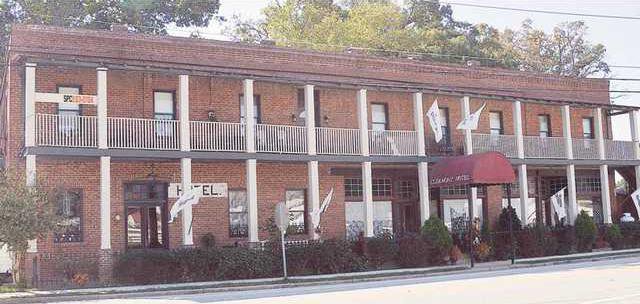Local video: Take a video tour inside the Clermont Hotel.
"We didn't know if it would be a antique store or a hotel," said Plumlee, who at one point considered turning the building into an assisted-living facility. "It took us five years to get it open. We bought it out of a bankruptcy and it was totally vacant."
During the five years, Potts, who worked as an interior designer before buying the hotel, added bathrooms and wallpaper and took down walls. She furnished the entire hotel and made updates to modernize the building.
The Clermont Hotel now welcomes visitors from all over and holds birthday parties and weddings.
According to longtime Clermont resident Robert Allison, the 13,000-square-foot hotel was built in 1912 by T.C. Miller.
"Well, what it really was, when the train was running through there, people would come on their travels from somewhere or another," he said. "The old school, the two-story school house, kept boarders there and people would come from all over the country to try and go to school there (Chattahoochee High School)."
The hotel fell on hard times after the train quit running through Clermont.
"I can remember that after the train quit running that they were renting apartments out to people for them to live in," said Allison, who added the Haynes family owned the hotel at that time. "It would cost you $10 a month to rent you a place to live, and it stayed full.
"I don't think that I ever stayed there, but my aunt had a room there and I had friends over there."
Years ago the Clermont post office was housed in the hotel, Potts and Allison agreed.
The original building had 20 rooms, tea rooms and one single bath, according to the hotel's Web site. Currently, the hotel has seven rooms for guests. The downstairs lobby, dining room, bar and kitchen today are close to their original locations.
"The whole front is original, all the glass is original," Potts said. "There is a slab of concrete under the (lobby) floor, there is no basement. Evidently they also had a feed store in here, so in order to have that heavy stuff in here I'm sure it was concrete.
"This is the same floor; when we bought it I kept it this way," Potts said. "You can see where it (the floor) was painted here. You cannot sand these down for refinishing; they tried upstairs a couple years ago and it was a mess because they are so uneven. A few of the rooms I did have to add carpet."
During the lifetime of the historic building, different innkeepers have run the hotel. In the 1930s, John Milton Haynes owned the hotel, which he renamed the Haynes Hotel. Then Sara Herndon bought the hotel from Haynes and named it The Colony House.
The second floor of the building is where the bulk of the guest rooms are located. The hallway and common areas are painted and upholstered in a peachy-pink theme.
"I call it a peach," Potts said. "Everything was Confederate gray, if you can imagine how depressing that was.
The furniture has come from everywhere ... in order to get the bathrooms in, I had to break the rooms up into two different rooms."
There is a bridal suite upstairs, which guests from about 20 different weddings have enjoyed.
"Each room is totally different, and I had to do it a little bit at a time," Potts said. "I could write a book about the hotel."
The hotel, according to Clermont mayor James Nix, is a nice addition to downtown Clermont.
"It's a nice old building," Nix said. "It's something that most people in Clermont like to see it still be there."

